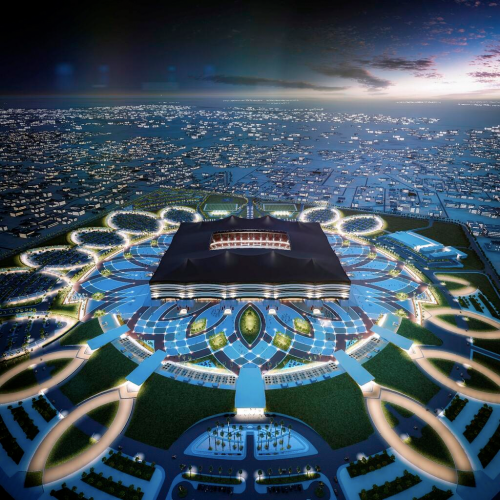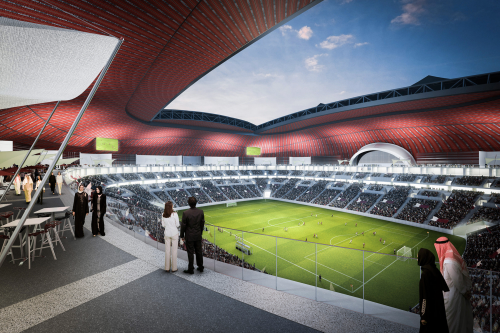
Quatar’s al bayt stadium showcases tent-like design
In 2022, the new Al Bayt Stadium will have the capacity to host 60,000 spectators, and will fulfill all FIFA requirements for hosting FIFA World Cup™ matches through the semi-final round. Dar Al Handasa serves as the design consultant for Al Bayt Stadium and Precinct, and Projacs serves as the project manager.


[ design ]
Al Bayt Stadium perfectly embodies the spirit of Qatar. Using the latest technologies and breath-taking innovations, it tells the story of a nation that, in times of both scarcity and plenty, has welcomed visitors into its warm embrace and treated them as family, regardless of differences in background, history or culture.
For centuries, Qatar has been home to both nomadic and sedentary populations. The nomadic population lived primarily in the desert and herded animals, including camels, sheep and goats. The country’s sedentary population primarily lived along the coastline, engaging in pearl diving, fishing and trading with neighboring settlements. Although located close to Qatar’s coast, Al Bayt Stadium and Precinct will introduce fans and visitors from around the world to the culture of the desert.
Al Bayt Stadium is modeled after Bayt Al Sha’ar, a tent traditionally used by nomadic peoples in Qatar and neighboring countries. The distinctive exterior, black with prominent white stripes, served a number of purposes. The width and number of white stripes identified the tribe of the owner. The tent was easily spotted from afar. For those traveling through the sometimes harsh landscapes of the desert, the site of a black-and-white striped tent on the horizon meant an invitation to enjoy the hospitality of the tent’s owner, whether known or not to the traveller. Al Bayt Stadium will carry on this tradition, beckoning football lovers near and far, bringing them together to put aside their differences in a global celebration of the beautiful game.
The tent’s exterior was also optimized for staying cool in the summer and warm in the winter, just as Al Bayt Stadium will maintain ideal temperatures for player performance and fan comfort year-round.
The tent’s interiors contrast sharply with their monochromatic exteriors. The red, patterned interiors, in a traditional Sadu pattern that differed from area to area and family to family, greeted visitors who stepped inside the Bayt Al Sha’ar, enveloping them in the warmth of their hosts and inviting them to relax and shelter from the elements. Likewise the interior of Al Bayt Stadium, where the Sadu pattern will provide visitors from abroad with a taste of traditional Qatari design, and remind local fans of their heritage.
[ sustainability ]
Of necessity, the tents upon which Al Bayt Stadium is modeled are uniquely sustainable and suitable to the deserts in which they are found. They are named after the animal hair from which they were woven with care, from the same animals that grazed outside. Despite the relative simplicity of their design, they were expected to fulfill a number of requirements. They had to be quick and easy to erect and deconstruct, and light enough to be carried by pack animals, sometimes for long distances; they needed to be airy and cool in the summer, and warm and cozy in the winter.
Al Bayt Stadium shares the dedication to sustainability witnessed in generations of tent-dwellers. Employing the latest construction techniques and materials, the stadium will target both Leadership in Energy and Environmental Design (LEED) and Global Sustainability Assessment System (GSAS) ratings. To achieve Qatar’s goal of hosting a carbon neutral 2022 FIFA World Cup™, the stadium and precinct will incorporate green building materials that minimize embedded carbon, and incorporate energy usage best practices. In addition, renewable energy will be generated within Al Bayt Precinct, further reducing the carbon footprint.
[ legacy ]
Qataris today can be found traveling to every corner of the world. As the country has gained a more global perspective, herding animals has become much less prominent in the life of the nation. However, Bayt Al Sha’ar still plays a prominent role in the lives of many Qatari families. It is a gathering place, where the old can teach the young about bygone eras, before Qatar began to develop rapidly. It is also used to preserve the traditions of the desert. Outside of many Bayt Al Sha’ar, you will find a post upon which hunting falcons perch as their owners enjoy a glass of tea and tell stories of the hunt inside the tent.
Just as the Bayt Al Sha’ar remains central to family life in Qatar, the precinct surrounding Al Bayt Stadium will become a centre of community life in the city. Landscaped paths will welcome residents seeking exercise, whether on foot, on bicycles or riding horses. Retail areas will create opportunities for small businesses to thrive.
Further echoing the Bayt Al Sha’ar, parts of Al Bayt Stadium will be transportable. In line with the SC’s legacy commitments, the upper tier of Al Bayt Stadium will be demountable. In the years after 2022, the stadium’s upper tier will be removed. The modular parts will be used to build stadiums in countries around the world that lack adequate sporting infrastructure.
This spirit of giving, so deeply embedded in Qatari culture, will repeat itself across all of the stadiums being delivered by the SC and its stakeholders, creating a legacy of football development across the world. The culture of generosity and caring for neighbors, practiced for centuries in the deserts of Qatar, will become a model for building a better future for all of us.



